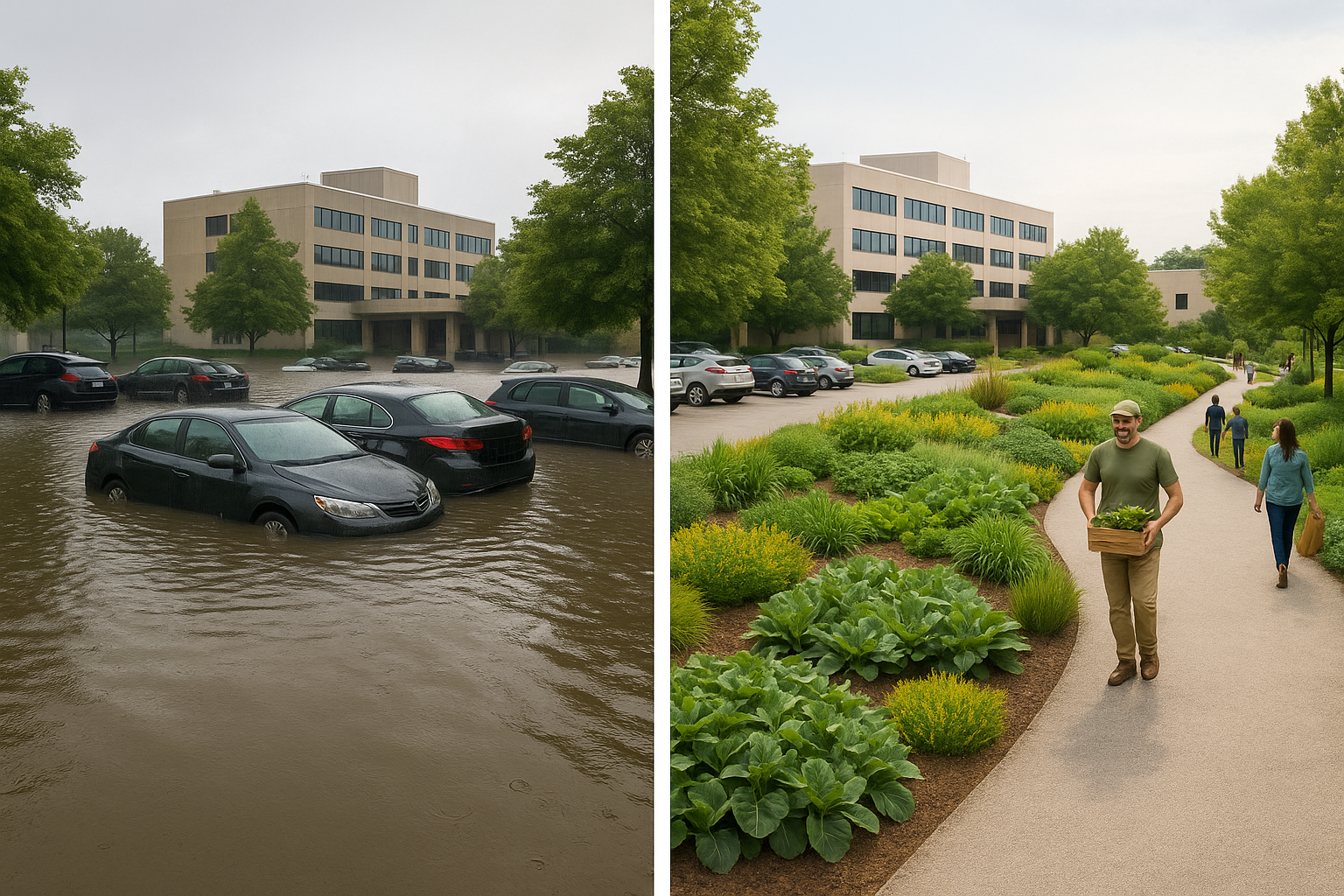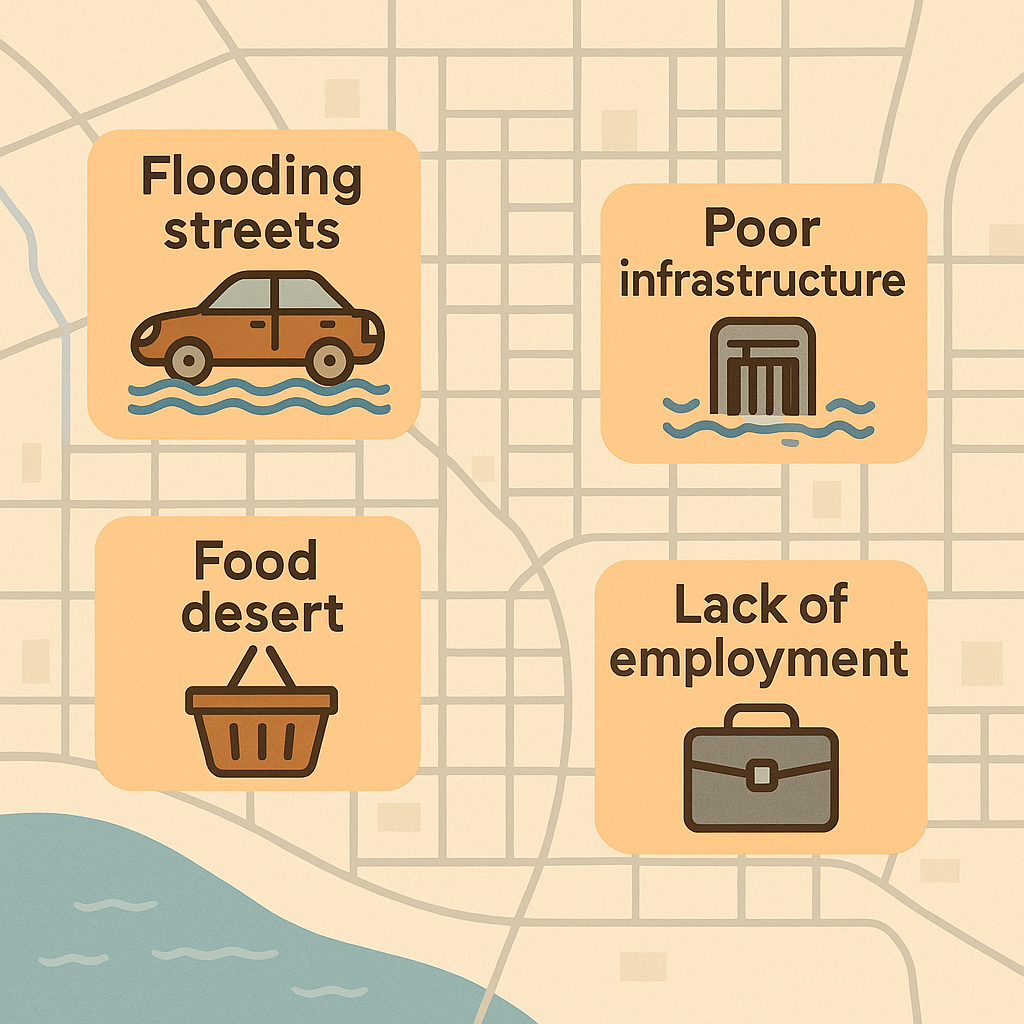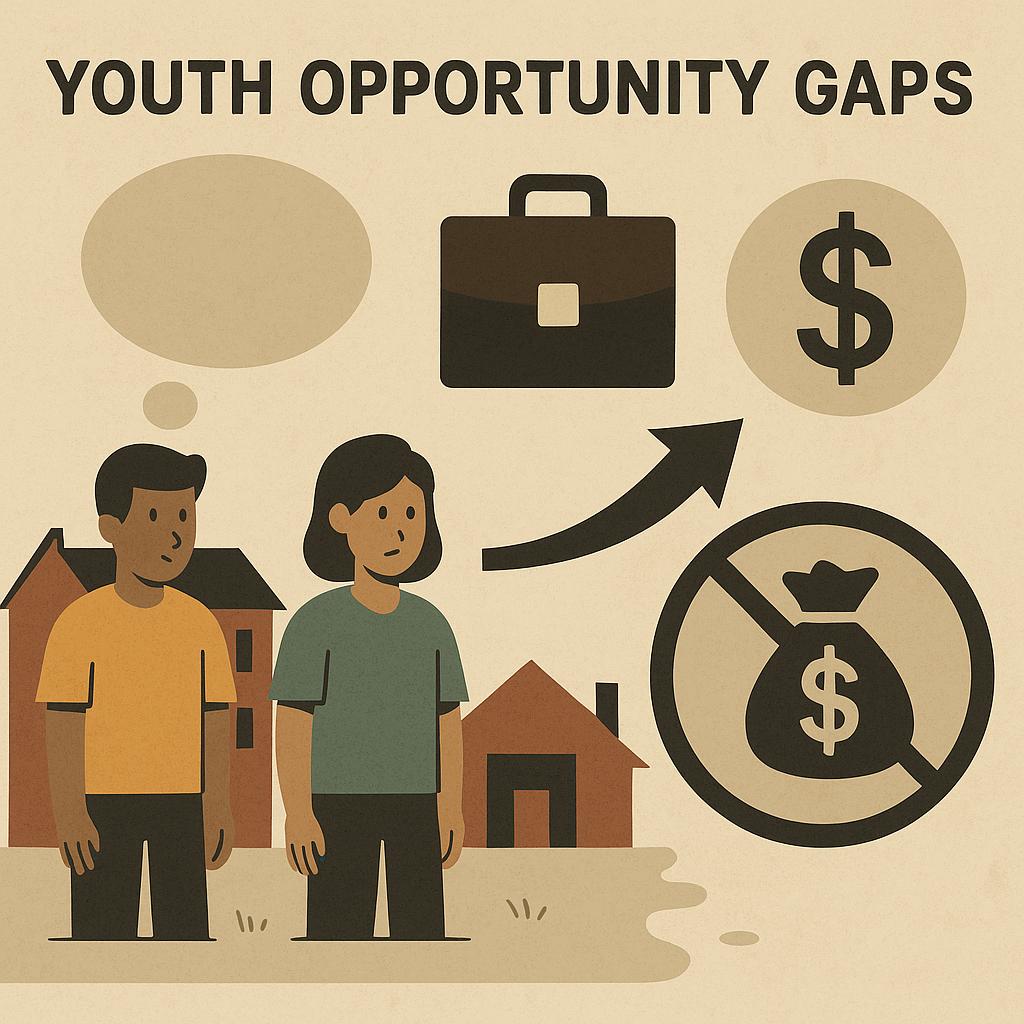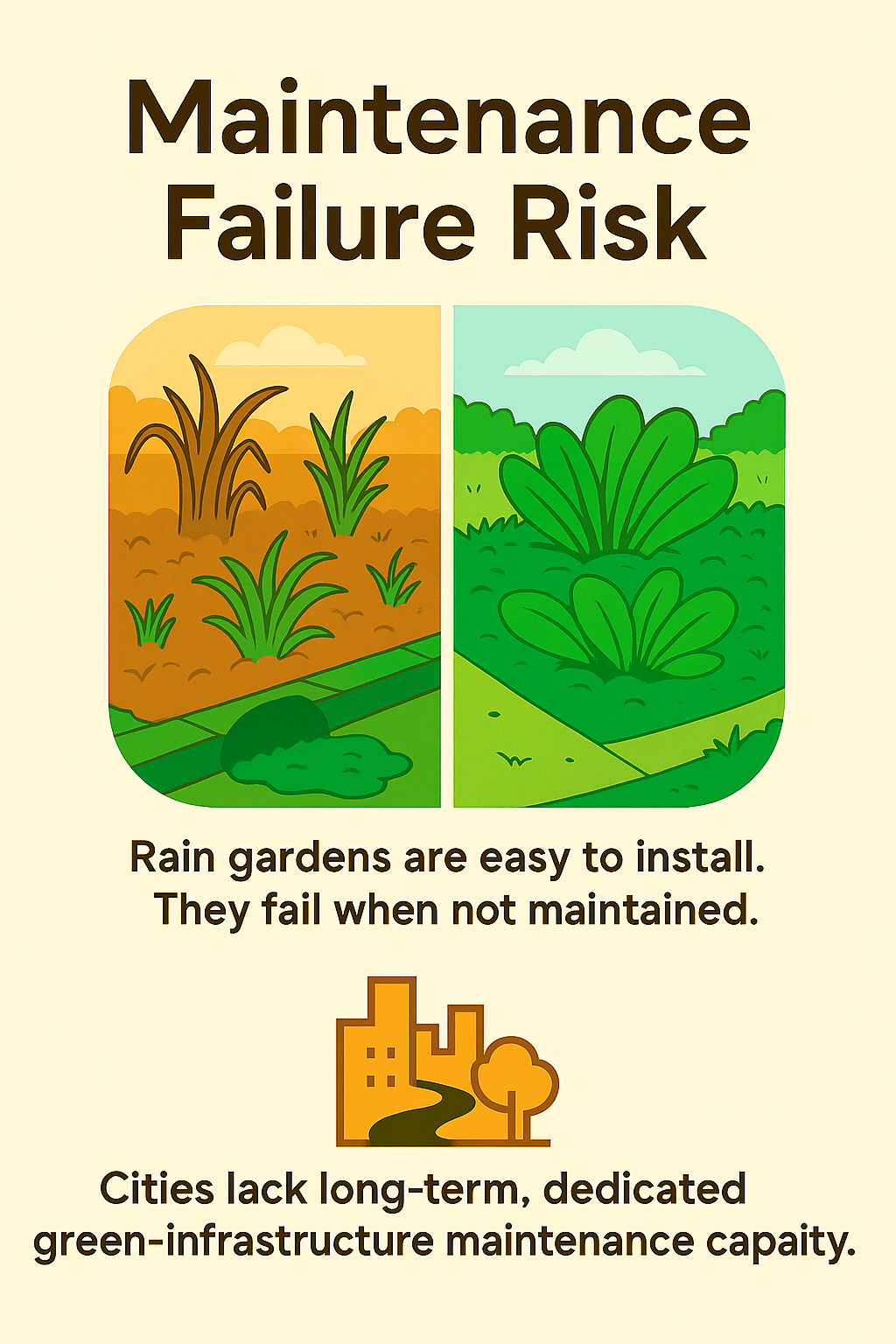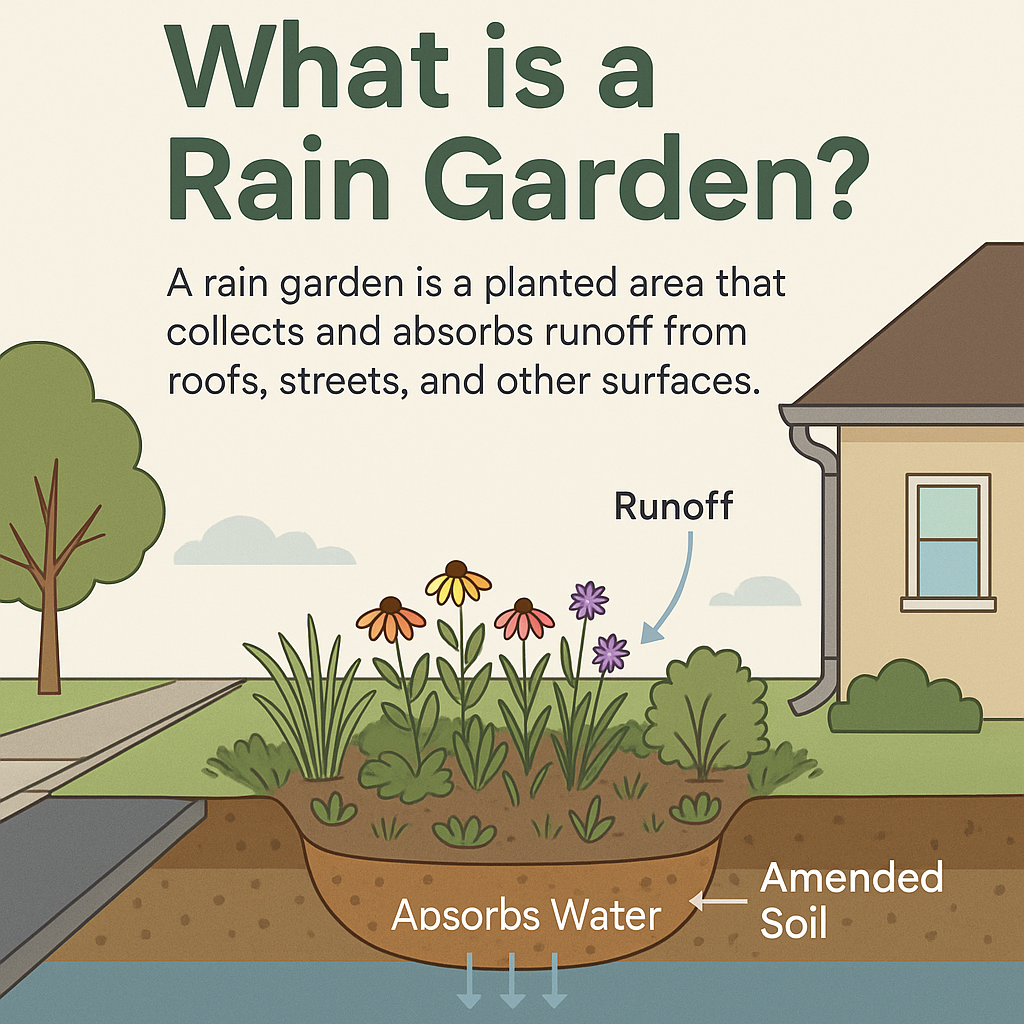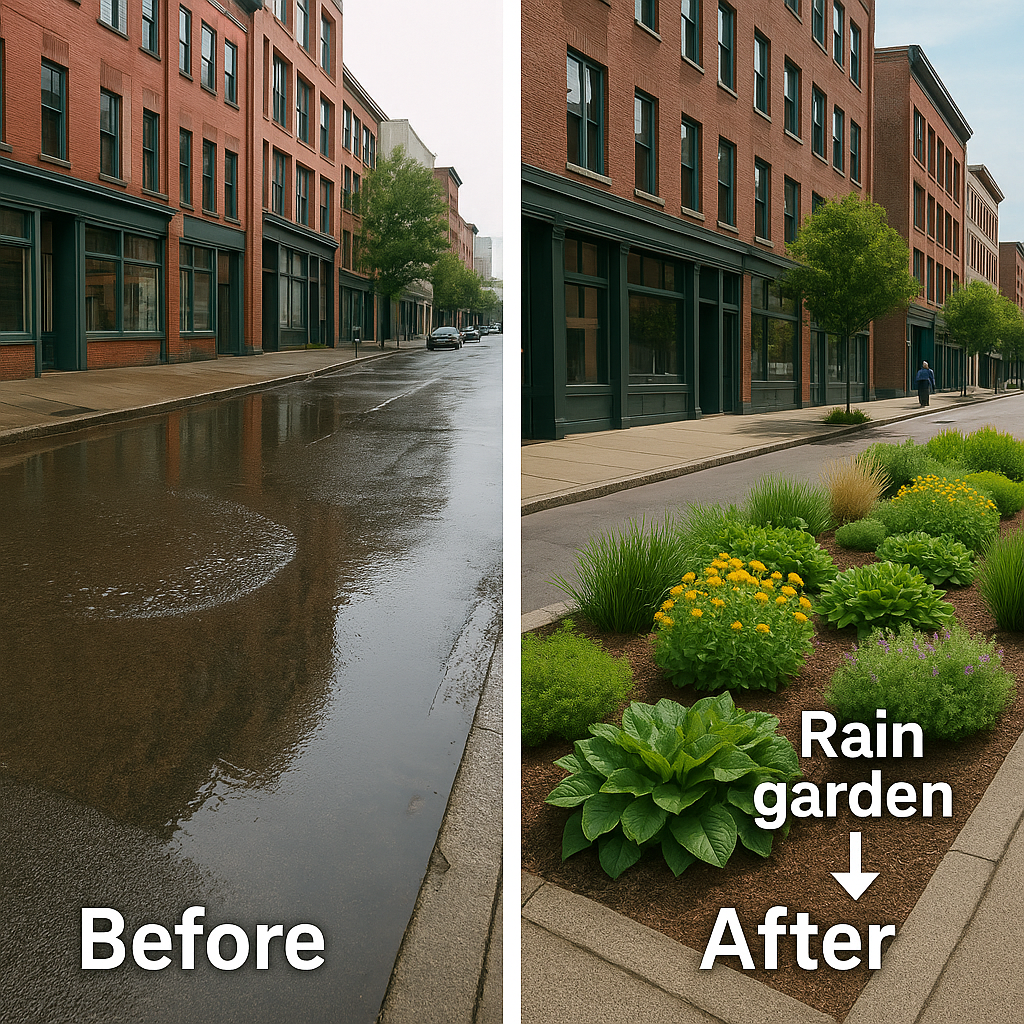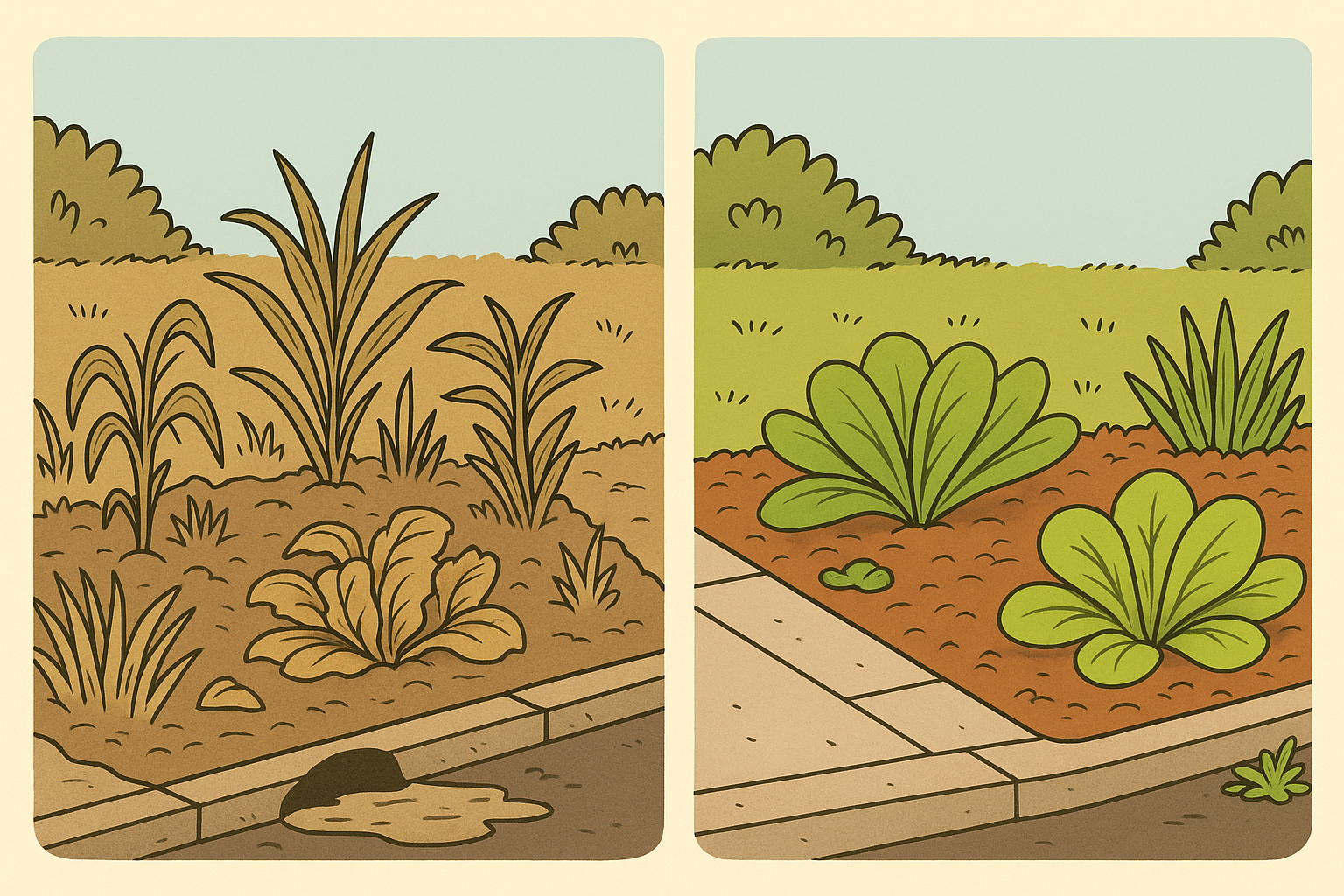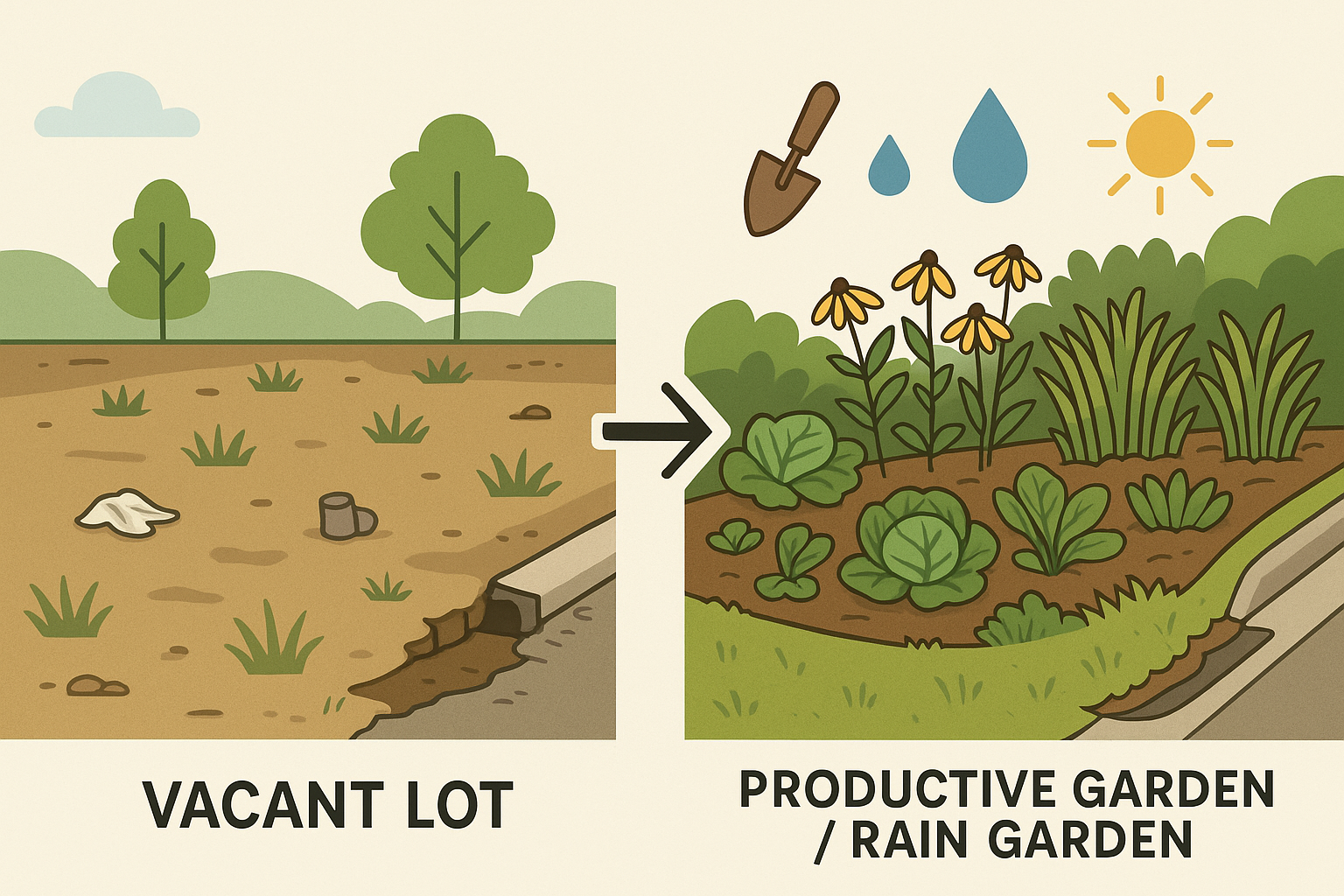Rain Garden Strategy
by North Star Group
Federal Funding for Stormwater Management
Community Rain Garden Corps
Training youth to solve flooding, food access, and maintenance problems simultaneously
The Problems We Face
Our Solution
What We Achieve
Executive Summary
Political Success Model
Mayor Toby Barker of Hattiesburg has brought in over $100 million in federal and state grants for infrastructure projects since 2017. 85% of voters re-elected him, winning every voting area in the city. His approach focuses on bringing stakeholders together and showing voters tangible results.
Federal Funding Available
$50-100 Million in federal grants available for projects that address flood management and food access.
What Are Rain Gardens?
Results from Other Cities
- 2,100+ rain gardens built since 2010
- 29 million gallons of flood water managed yearly
- $4,200 average rebate to property owners
- 95% resident satisfaction
- 3 billion gallons of overflow prevented yearly
- $6.5 billion saved vs concrete infrastructure
- 85% pollution reduction achieved
- First US city to meet federal water standards with green infrastructure
EPA Research Results
- 90% removal of dirt and debris
- 98% removal of heavy metals
- 83% removal of phosphorus
- 30-60% cost savings vs concrete infrastructure
- 42% cost reduction documented in Cincinnati
- Property values increase 3-5%
Mobile County *(your jurisdiction's information will differ)* Context
- 66+ inches yearly rainfall (among highest in US)
- Documented flooding issues in 311 calls
- Food access challenges in rural areas
- MS4 permit coordination across multiple jurisdictions
- Local Community Partners: 20+ community gardens operating
- Master Gardeners: qualified horticultural experts, qualified horticultural experts with technical expertise
- MapArea platform: GPS documentation system
- Extension partnership: Alabama Cooperative Extension support
Federal Requirements
Municipal Separate Storm Sewer System permit requires stormwater management documentation and performance reporting. Current permit expires September 30, 2026.
Rain gardens provide one approach to meet federal requirements while offering additional community benefits. Traditional infrastructure also meets compliance standards.
Federal Funding Programs
50% grant funding available
75-90% federal funding
Alabama track record
Multi-benefit projects
Program Strengths
- Federal compliance: Addresses MS4 permit requirements
- Multiple benefits: Flood management, food access, community engagement
- Technology platform: MapArea system for documentation
- Local expertise: Master Gardeners and Extension support
- Grant application support: Professional assistance available
Implementation Timeline
Technical Reference: Alabama Rain Garden Handbook
Alabama Department of Environmental Management provides rain garden implementation standards covering site selection, construction, plant selection, and maintenance for Alabama conditions.
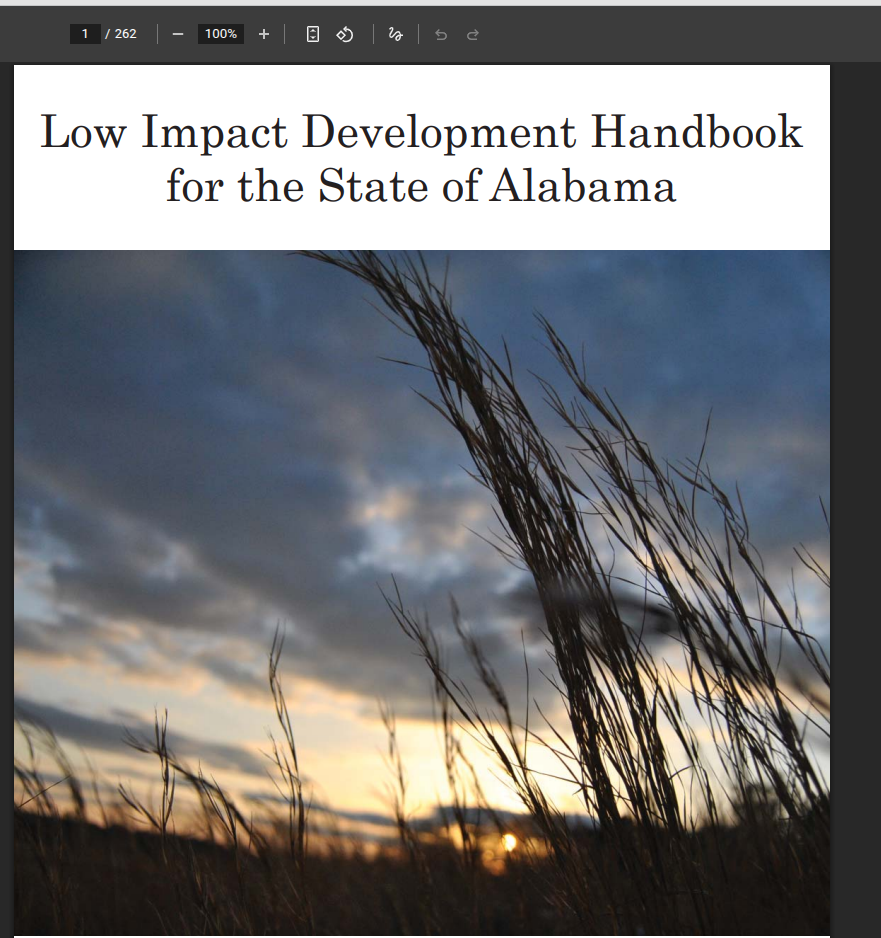
Construction Guidelines (13 pages)
Source: Alabama Department of Environmental Management, Low Impact Development Handbook for the State of Alabama, Chapter 5.1: Rain Gardens. Technical specifications for MS4 Phase II compliance.
The Problem
Mobile County *(your jurisdiction's information will differ)* Water Quality Context
Documented Water Quality Issues
State monitoring shows several Mobile County *(your jurisdiction's information will differ)* waterways fail bacteria safety standards. Stormwater runoff from developed areas carries contamination directly into local creeks and Mobile Bay.
Water Quality Monitoring Results
- Halls Mill Creek: Listed as impaired for bacteria and organic pollution
- Fowl River: Requires up to 97% bacteria reduction
- Mobile Bay (Point Clear): Fails safety tests 46% of the time
- Rabbit Creek & Deer River: Contaminated by urban runoff
- Pet waste, fertilizers, oil, and debris from developed areas
- First inch of rainfall carries 90% of pollutants
- Storm drains discharge directly to waterways
- 66+ inches annual rainfall in Mobile County *(your jurisdiction's information will differ)*
Federal Requirements: Clean Water Act
Municipal Separate Storm Sewer System (MS4) Program
The 1987 Clean Water Act Amendment requires counties with population over 50,000 to regulate stormwater discharge. Mobile County *(your jurisdiction's information will differ)* must maintain a stormwater management program and demonstrate progress in controlling pollution discharge every 5 years.
MS4 Permit Requirements
| Requirement | Description | Implementation Example |
|---|---|---|
| Public Education | Community outreach about water pollution | Workshops, educational materials |
| Runoff Reduction | Demonstrate stormwater capture and treatment | Measurable water capture systems |
| Pollution Prevention | Reduce contamination before it reaches waterways | Source control, filtration systems |
| Performance Documentation | Annual reporting to regulatory agencies | Monitoring data, program effectiveness metrics |
Compliance Standard
Maximum Extent Practical
Federal regulations require stormwater management programs that reduce pollution discharge "to the maximum extent practical." This standard focuses on demonstrable progress and program implementation rather than elimination of all pollution.
Jurisdictional Coordination
Mobile, Prichard, Chickasaw, Mt. Vernon
Saraland, Satsuma, Creola, Semmes
Bayou La Batre, Dauphin Island, Citronelle
Permit Timeline
Current MS4 Phase II permit expires September 30, 2026. Permit renewal requires demonstration of program effectiveness and continued compliance with federal standards.
Compliance Approaches
Alabama Department of Environmental Management accepts various stormwater management approaches that demonstrate measurable water quality improvements. Options include traditional infrastructure, green infrastructure systems, or hybrid approaches. Counties evaluate costs, timelines, and effectiveness when selecting compliance strategies.
Rain Garden Application
Rain gardens represent one approach to address documented water quality issues in specific watersheds. They can provide measurable pollution reduction while offering potential additional community benefits. Implementation would target contaminated areas identified in state monitoring data.
The Solution
Federal Funding Portfolio
Bipartisan Infrastructure Law Impact
Alabama received $3 billion, with $537 million for water infrastructure. Mobile County *(your jurisdiction's information will differ)* positioned for major investment through multi-agency application strategy.
Tier 1: Alabama State Revolving Fund ($20-50M)
FY 2025 Allocation: $43.7 million total, with 50% grant/forgiveness for disadvantaged communities. Green infrastructure explicitly eligible.
| Component | Amount | Rain Garden Eligibility |
|---|---|---|
| Clean Water & Stormwater | $27.8M | Primary eligibility |
| Drinking Water Infrastructure | $13.5M | Source water protection |
| Emerging Contaminants | $2.4M | Natural filtration benefits |
Tier 2: FEMA BRIC ($10-25M)
- $750M available nationally
- Projects up to $50M eligible
- 75% federal share (90% for disadvantaged areas)
- Philadelphia: $25M green stormwater infrastructure
- Virginia Beach: $25M drainage improvements
Tier 3: USDA Rural Development ($5-15M)
Alabama Track Record: $8-10 million typical awards. Serves communities under 10,000 population (significant Mobile County *(your jurisdiction's information will differ)* portions qualify). Strong state partnerships established.
Tier 4: DOT RAISE Transportation ($5-20M)
Alabama Success Model: Tuscaloosa received $17M for transportation corridor improvements. Mobile County *(your jurisdiction's information will differ)* can integrate rain gardens with transportation infrastructure for multi-benefit federal appeal.
Additional Federal Programs ($5-15M)
Community projects in underserved areas
Neighborhood integration (County has Entitlement status)
Gulf Coast climate adaptation
Portfolio Strategy
FY 2025-2027
Minimal county match
Risk Mitigation: Multi-program approach reduces dependence on single agency while maximizing total investment. Phased implementation accommodates varying funding timelines.
Innovation
Rain Garden Innovation
Dual-Purpose Infrastructure
Rain Garden Food Systems simultaneously manage federal stormwater compliance and produce food, creating the only federal grant proposal addressing infrastructure resilience, environmental justice, food security, and economic development in a single integrated approach.
Federal Compliance Integration
| MS4 Requirement | Traditional Approach | Rain Garden System |
|---|---|---|
| Public Education | Brochures, workshops | Community-led installation programs |
| Runoff Reduction | Concrete retention ponds | Distributed water capture |
| Performance Documentation | Periodic inspections | GPS-mapped installations with professional reporting |
Proven Success Models
- 2,100+ installations addressing federal violations
- 95% resident satisfaction
- Measurable city-wide flood reduction
- $4,740 average municipal rebates
- 42% cost savings vs conventional infrastructure
- NPDES permit compliance achievement
- EPA technical assistance and funding
- City-wide adoption with performance metrics
Success Factor Analysis
Federal compliance mandate created legal requirement rather than optional environmental project. Municipal utility funding combined with federal technical support provided sustainable financing. Community-driven implementation with professional oversight ensured participation and performance.
Mobile County *(your jurisdiction's information will differ)* Competitive Advantage
- FEMA: Infrastructure resilience
- EPA: Environmental justice
- USDA: Food security and rural development
- DOT: Economic development
- Local Community Partners: 20+ garden network
- Extension Master Gardeners: Scientific expertise (qualified horticultural experts - microbiologist/water quality, qualified horticultural experts - PhD healthcare/horticulture)
- North Star Group: 9 U.S. patents, proven technology
- Garden Advisor platform captures aging expert knowledge
- Digital preservation of specialized techniques
- Photo diagnosis system for ongoing support
- Scalable to other Gulf Coast communities
Cost and Performance Analysis
vs traditional infrastructure
through community ownership
Federal Grant Differentiation
While other communities propose standard stormwater solutions, Mobile County *(your jurisdiction's information will differ)*'s edible rain gardens appeal to multiple federal agencies simultaneously, increasing funding probability and total investment potential while addressing documented food access challenges affecting 25% of county residents.
Research Foundation
Scientific Research Foundation
Peer-Reviewed Evidence Supporting Innovation Claims
University of Melbourne researchers have published the most robust peer-reviewed data available on vegetable rain gardens, demonstrating successful food production while maintaining stormwater management effectiveness. Their work provides the scientific foundation for implementing edible rain garden programs at municipal scale.
Key Research Findings from Published Studies
- Lead researchers: P.J. Richards, N.S.G. Williams, T.D. Fletcher, C. Farrell
- Publication: "Can raingardens produce food and retain stormwater?"
- Study type: Controlled greenhouse pot experiment
- Key finding: Vegetable raingardens can both retain stormwater and produce vegetables
- Optimal system: Potting mix with surface watering for dual functionality
- Authors: P.J. Richards, C. Farrell, M. Tom, N.S.G. Williams, T.D. Fletcher
- Publication: "Vegetable raingardens can produce food and reduce stormwater runoff"
- Study type: Field-scale experimental rain gardens at Burnley Campus
- Key finding: Two vegetable raingardens (lined and unlined) successfully demonstrated dual functionality
- Research contact: Dr. Claire Farrell, University of Melbourne
Technical Specifications Validated by Research
| Research Finding | Source | Application to Mobile County *(your jurisdiction's information will differ)* |
|---|---|---|
| 20-50% potting mix in biofilter sand produces optimal results for vegetable growth | University of Melbourne, 2017 | Standardized soil specifications for county installations |
| "Type of vegetable largely irrelevant; they all produce a good yield" | Dr. Claire Farrell, 2017 | Flexible plant selection for diverse community preferences |
| Combination of surface and underground watering provides ideal vegetable growth conditions | Green Infrastructure Research Group | Design guidelines for sub-irrigation systems |
| Unlined systems preferred for food production applications | Richards et al., 2015 | Infiltration-type rain gardens maximize both stormwater management and crop yields |
Municipal Program Evidence
Philadelphia Edible Rain Garden Pilots
Philadelphia Orchard Project has documented installations at Greenfield and Lea Elementary Schools featuring juneberries, pawpaws, blueberries, and chokeberries integrated into rain gardens. While harvest data remains unpublished, these pilot projects demonstrate municipal acceptance of edible stormwater management concepts.
Note: Philadelphia Water Department guidelines state "Do not plant edible food in a rain garden" due to contamination concerns, highlighting the need for proper design protocols.
Portland's Municipal Rain Garden Program
Portland Bureau of Environmental Services has completed over 250 private property rain garden projects since 2010. While focused on stormwater management rather than food production, the scale demonstrates proven municipal implementation capacity and partnership models with property owners.
Research Institutions and Contacts
- Primary contact: Dr. Claire Farrell
- Research group: Green Infrastructure Research Group
- Email: cfarrell@unimelb.edu.au
- Focus: Plant selection for urban green infrastructure
- Role: Lead researcher on stormwater and waterway health
- Institution: University of Melbourne, Burnley Campus
- Expertise: Household-level stormwater initiatives
- Quote: "Intercepting stormwater where it falls before it accumulates is the most efficient way to manage it."
- Ecological Engineering: 2017 Richards et al. study
- ResearchGate: 2015 Richards et al. study
- Popular science: University of Melbourne Pursuit
Municipal Implementation Models
Portland Bureau of Environmental Services Model
Portland's private property rain garden program demonstrates successful municipal-private partnerships. Key elements include: property owner selection based on public sewer system needs, full municipal funding for installation, signed maintenance agreements, and documented success in saving ratepayers money while helping replenish groundwater.
Food Safety and Contamination Research
Melbourne Heavy Metal Study
University of Melbourne research documented acceptable metal concentrations in vegetables grown with stormwater irrigation, with comprehensive testing protocols for regulatory compliance. However, proper site assessment and design protocols remain essential for food safety.
Municipal Food Safety Concerns
Philadelphia Water Department currently advises against edible plantings in rain gardens due to contamination concerns, highlighting the importance of proper design protocols, site selection, and water quality testing for any edible rain garden implementation.
Research Gaps and Grant Opportunities
Identified Research Needs
- Standardized quantitative yield measurements from municipal-scale installations
- Long-term productivity studies exceeding the current 18-month research duration
- Comprehensive food safety protocols for different soil and water quality conditions
- Economic analysis of municipal implementation costs versus traditional infrastructure
- Climate adaptability studies for southeastern US conditions
Federal Research Partnership Opportunity
The convergence of proven technical feasibility from Melbourne research, documented municipal interest from Philadelphia and Portland programs, and critical research gaps positions Mobile County *(your jurisdiction's information will differ)* as an ideal location for federally-funded edible rain garden research that addresses both environmental resilience and food system security.
Technology Platform
Technology Platform: Garden Advisor + Area Mapper
Two-Part Digital Strategy
Combine county-wide flood documentation with expert gardening advice. Area Mapper handles federal paperwork for Mobile County *(your jurisdiction's information will differ)*'s MS4 permit, Garden Advisor preserves Master Gardener expertise before retirement.
Multi-Sector Partnership Structure
| Partner | Technical Assets | Value Contribution |
|---|---|---|
| Local Community Partners | Community trust, 20+ garden sites, Extension-trained board (qualified horticultural experts & qualified horticultural experts) | Manual development, community engagement, grant administration |
| North Star Group | Software development, systems integration, Area Mapper platform | Digital platform development, technical infrastructure |
| Mobile County *(your jurisdiction's information will differ)* | County-wide jurisdiction, regulatory authority, MS4 Phase II permit responsibility | Permitting coordination, county flood data integration, public resource access |
Critical Knowledge Preservation Challenge
Gulf Coast gardening expertise is concentrated in aging Extension Master Gardeners. qualified horticultural experts and qualified horticultural experts have decades of local plant knowledge. Garden Advisor captures this wisdom through photo diagnosis before retirement losses occur.
Garden Advisor: Expert Knowledge Platform
- Take photo of plant problem or garden question
- Get advice based on Carol & Pat's expertise
- Learn techniques specific to Gulf Coast conditions
- Track progress with photo documentation
- Photo-based login: No SMS costs, user-selected images
- Hybrid AI model: Starts with commercial API, learns locally
- Offline capability: Works without internet after training
- Extension integration: Uses Alabama Cooperative Extension data
Area Mapper: County-Wide Federal Documentation System
- Unincorporated areas: Primary focus on county jurisdiction
- GPS-precise reporting: Flood and stormwater issues
- Photo documentation: Evidence with location data
- Community participation: County-wide engagement tracking
- MS4 Phase II compliance: County permit documentation
- GeoJSON files: Alabama SRF grant applications
- Professional PDFs: FEMA BRIC flood mitigation grants
- QGIS packages: DOT transportation corridor analysis
Mobile County *(your jurisdiction's information will differ)* MS4 Permit Focus
Mobile County *(your jurisdiction's information will differ)*'s Phase II MS4 permit covers unincorporated areas county-wide. Platform documents stormwater issues and solutions across the entire county jurisdiction, separate from municipal permits.
Area Mapper automatically formats county resident reports into federal documentation required for MS4 permit renewal and grant applications.
Three Rain Garden Approaches
Food production focus with QR codes for local sales, payment processing, micro-commerce support
Beautiful landscaping with native plants, butterfly attractors, seasonal interest planning
Maximum flood control with minimal maintenance, built for function over beauty
Technical Development Timeline
County-Wide Implementation Benefits
- Extension expertise: Carol & Pat's knowledge preserved digitally
- County-wide access: All unincorporated residents benefit
- Scalable training: Platform teaches proper techniques
- Documented need: County-wide flood issue mapping
- Community engagement: Platform usage shows participation
- Professional output: Grant-ready documentation automatically
Innovation Value: Garden Advisor brings Carol and Pat's expertise directly to residents' phones. The digital platform scales their knowledge to thousands of people county-wide, something impossible through traditional one-on-one Extension advice.
MapArea Platform Screenshots
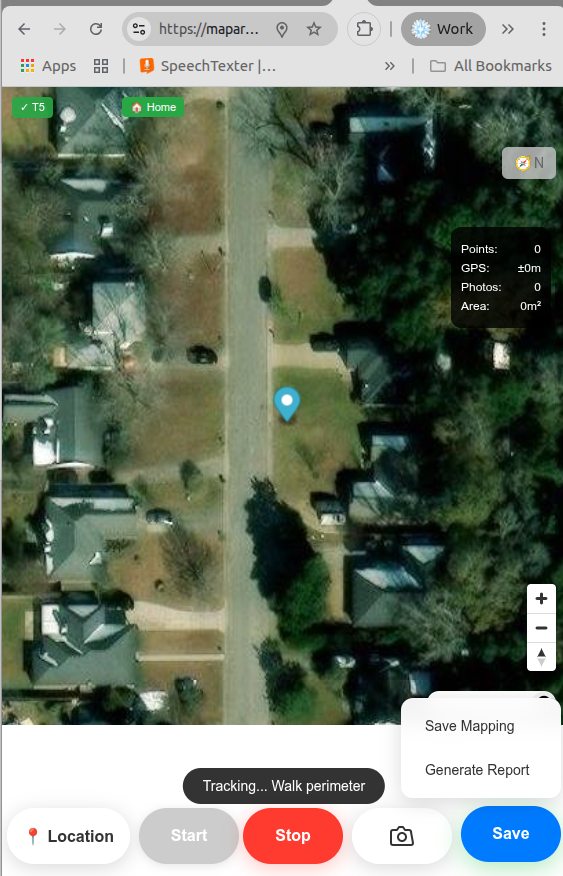
Secure 2FA login with GPS perimeter tracking for federal grant documentation
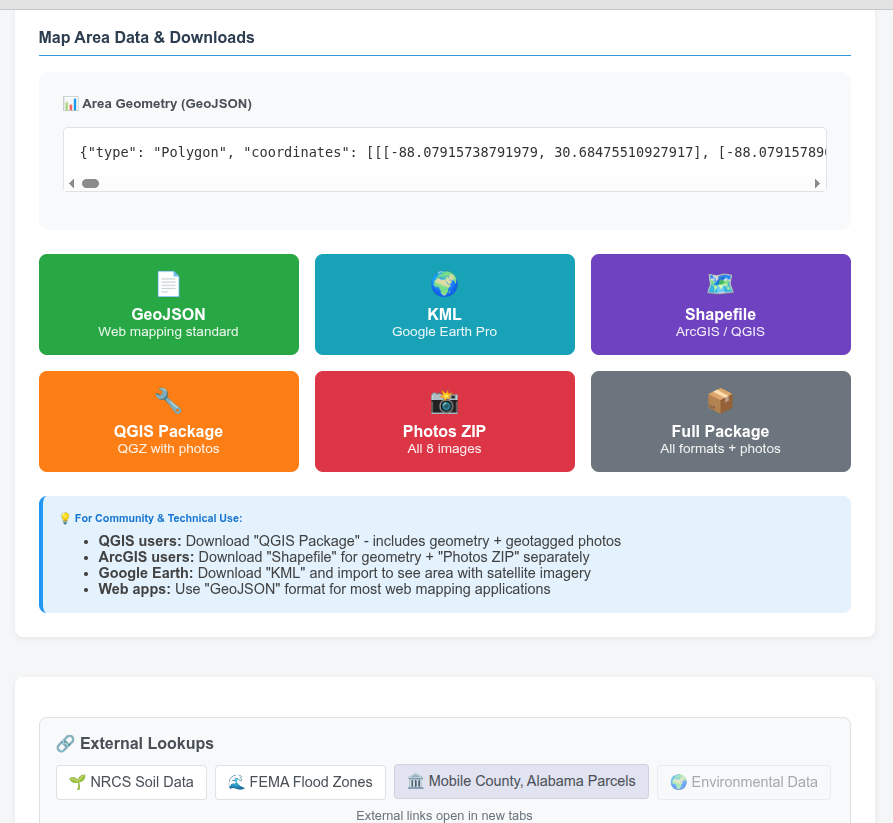
Multiple format exports: GeoJSON, KML, Shapefile, QGIS packages for federal applications
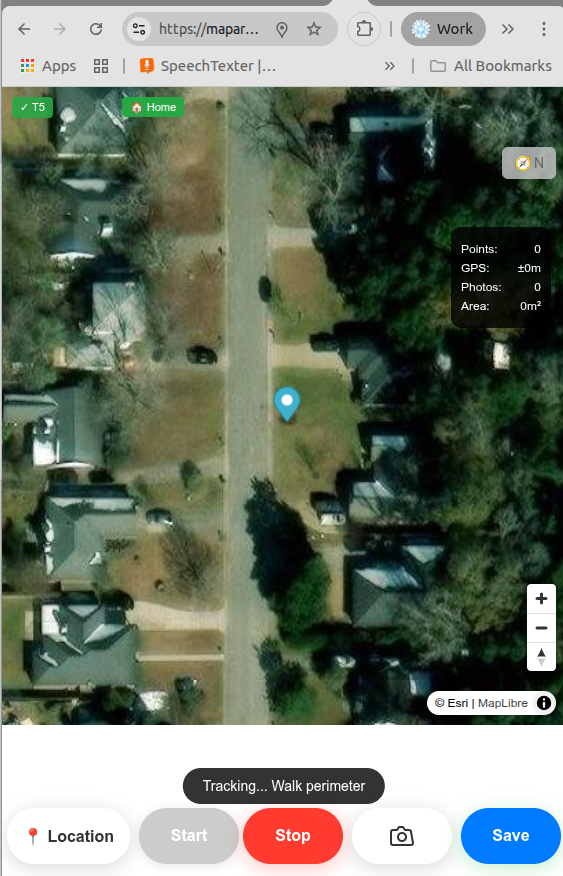
Step-by-step GPS setup for accurate perimeter mapping
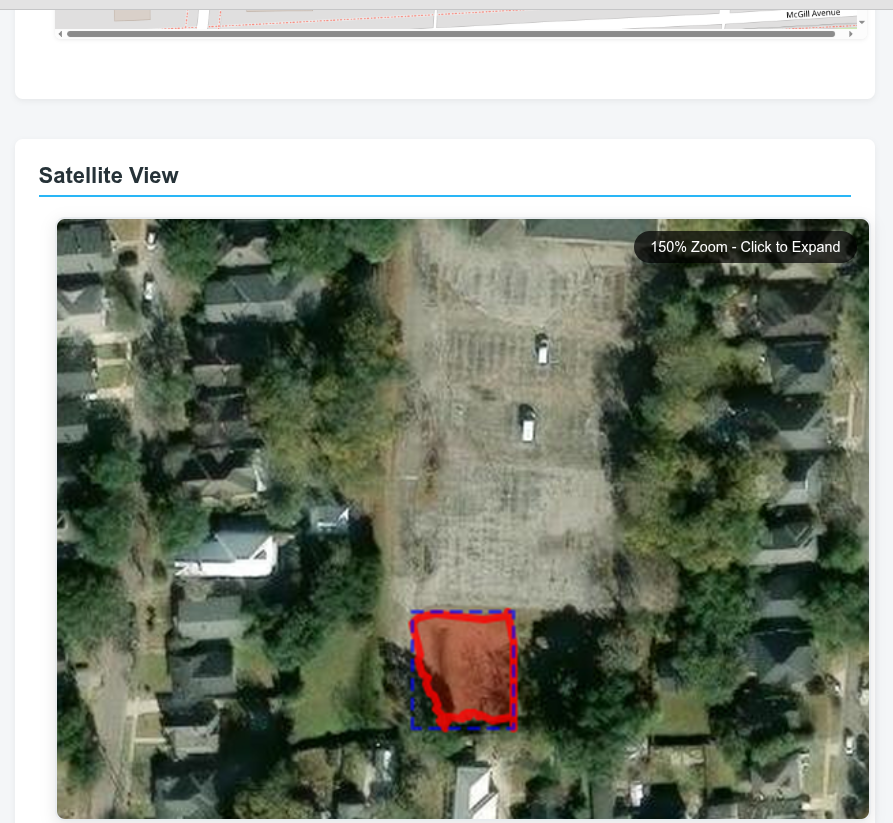
High-resolution satellite imagery with GPS boundary overlay

Geotagged photos with timestamp for federal evidence requirements

Automatically generated reports with area calculations, GPS coordinates, and photo documentation
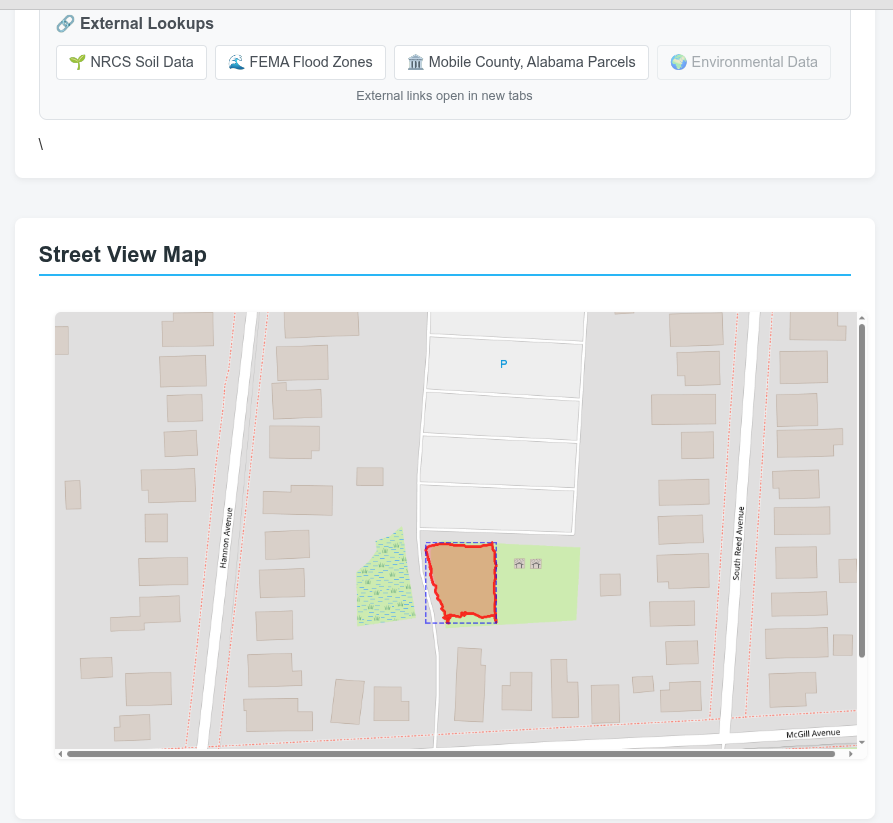
Street-level context mapping for comprehensive site documentation
Revenue and Sustainability
Platform development costs offset by federal grant success, MS4 compliance efficiency
67 Alabama counties face similar MS4 requirements, platform licensing potential
Documented community engagement and technical solutions strengthen all grant applications
Demonstration
Live Demonstration: Report #55
McGill Avenue, Hannon Park Professional Documentation
Community member "T5" created federal grant-ready documentation in 5 minutes using basic web interface. No specialized training, app installation, or technical expertise required.
- Area: 718 m² (7,729 ft²) with precise GPS coordinates
- Evidence: 8 timestamped photos with GPS metadata
- Professional Output: GeoJSON, KML, Shapefile, QGIS package formats
- External Integration: NRCS soil data, FEMA flood zones, county parcels
- Professional site assessment with sub-meter GPS accuracy
- Satellite imagery demonstrating flood risk context
- Comprehensive evidence package meeting federal standards
- Community engagement documentation for MS4 compliance
Scalability Impact
If one community member generates professional documentation in 5 minutes, Mobile County *(your jurisdiction's information will differ)* can rapidly develop comprehensive flood evidence across 11 jurisdictions. Each mapped area becomes supporting evidence for federal grants worth millions.
Live Platform Access
View Complete Report: maparea.nsgia.com/report/55
Implementation
Implementation Strategy
Three-Phase Federal Investment Approach
Scales from demonstration projects through major federal funding to regional replication, ensuring sustainable growth while maintaining compliance and community engagement.
Phase 1: Foundation (6-12 months)
- Alabama SRF demonstration phase ($2-5M)
- FEMA BRIC comprehensive proposal development
- Multi-jurisdictional coordination agreements
- Community engagement and site documentation
- County resolution supporting strategy
- Match funding commitments
- Administrative capacity designation
- ADEM partnership coordination
Phase 2: Major Implementation (1-3 years)
Phase 3: Regional Leadership (3-5 years)
Economic Development Integration
- Local installation industry creation
- Technical assistance capacity for other municipalities
- Technology platform licensing revenue
- Regional Gulf Coast green infrastructure leadership
ROI Analysis
ROI Analysis
Federal Leverage Impact
Rain garden approach provides 3:1 to 10:1 return on county investment through federal cost sharing and infrastructure savings.
Cost Comparison
| Approach | Total Cost | Federal Funding | County Investment | Net Savings |
|---|---|---|---|---|
| Traditional Concrete | $50-200M | $0 | $50-200M | Baseline |
| Rain Garden Systems | $15-60M | $12-54M (70-90%) | $3-6M | $44-194M |
Economic Co-Benefits
3-5% increase in participating neighborhoods, enhanced flood resilience
200-500 jobs during implementation, local industry development
Reduced flood impacts, improved nutrition access, community engagement
For $50-100M project
Per violation across jurisdictions
Federal Compliance Value
Maintained federal grant eligibility across all programs, enhanced disaster resilience reducing FEMA costs, regulatory certainty through proactive compliance.
Risk Management
Risk Management
Evidence-Based Mitigation
Strategy addresses documented challenges from other communities while leveraging Mobile County *(your jurisdiction's information will differ)*'s unique assets.
National Maintenance Research
Rain Garden Aftercare: Learning from Other Cities
Analysis of maintenance strategies from Philadelphia, Seattle, Boston, Richmond, and other cities provides proven models for sustainable rain garden programs and identifies common failure points.
National Rain Garden Maintenance Case Studies (5 pages)
- Professional oversight: Cities with paid staff/contractors succeed
- 3-5 year funding: Prevents abandonment after initial enthusiasm
- Mixed models work: Grants + fees + volunteers
- Job training programs: Create sustainable workforce
- Volunteer burnout: 100% volunteer programs fail within 2-3 years
- No maintenance plan: Gardens become eyesores, generate complaints
- Single funding source: Grant ends, program dies
- No technical backup: Problems go unfixed, community loses confidence
Source: Comparative analysis of rain garden maintenance programs in Philadelphia, Seattle, Boston, Richmond, New Haven, East Palo Alto, and Lawrence County. Research identifies both successful strategies and common failure modes.
Political and Community Resistance
Documented Barriers and Institutional Inertia
Rain gardens don't just change the water — they change the workflow. That can create friction. Engineers and contractors familiar with concrete systems may be less supportive of decentralized green solutions that reduce their role or revenue. Public officials worry that if gardens aren't maintained, they'll turn into eyesores or drainage complaints. Some residents have seen past projects fail and assume this will be more of the same. None of these concerns are irrational — they're just the reality of trying something different.
Other cities have faced this same challenge. Seattle set up 3- to 5-year maintenance contracts with local nonprofits and private firms to ensure new gardens stayed clean, working, and well cared for. Philadelphia used a mix of schoolyard programs and public-private partnerships to build in care from day one. These models aren't just about landscaping — they're about making sure the new system doesn't quietly fail for lack of follow-up.
Mobile County *(your jurisdiction's information will differ)* needs a version of this that fits here. That might mean hiring a local vendor, setting up a garden care team, or working with local training programs. But whatever the structure, it needs to be in place before installation — not as an afterthought. Good ideas fail when no one is in charge of keeping them working. We need to plan for success, not just hope for it.
Mobile County *(your jurisdiction's information will differ)* Mitigation
- Compliance Framing: "Federal law requires this anyway"
- Cost Advantage: "60% less than concrete alternatives"
- Voluntary Participation: Property owner choice with rebates
- Local Control: County grant management, not federal oversight
Technical Implementation Risks
| Risk Category | Mitigation Strategy |
|---|---|
| Gulf Coast Climate Challenges | Expert knowledge from Carol & Pat, MUG Advisor platform, professional maintenance fallback |
| Community Adoption Patterns | Rain Garden Ambassador program (paid positions), financial incentives, technology support |
| Federal Funding Delays | Multi-program portfolio approach, staggered application deadlines |
| Maintenance Program Failure | Mixed funding model, professional backup contracts, Extension partnership |
| Regulatory Changes | Green infrastructure exceeds minimum compliance standards |
Realistic Assessment
Expected Patterns from Other Communities
10–20% of gardens may need repairs or replacements within three years. Public excitement tends to decline unless care is structured and funded. Cities that succeed treat this as public infrastructure — with maintenance plans — not volunteer landscaping. The research shows successful programs plan for these realities from day one.
Mobile County *(your jurisdiction's information will differ)* Contingency Framework
Backup strategies include: Rain Garden Ambassador program creates paid maintenance workforce, Extension Master Gardeners provide technical backup, professional landscaping contracts for failed sites, secondary grant applications if timelines shift, and traditional infrastructure fallback if green methods fail at specific locations. Risk doesn't disappear — but evidence-based planning manages, contains, and mitigates these challenges.
Next Steps
Process Information
Federal Program Timing
FY 2025–2026 application periods for infrastructure funding programs. Application deadlines vary by program.
Coordination Options
- Commission presentation (if requested)
- Resolution development (if desired)
- Staff coordination assignment
- Local match determination
- ADEM program guidance
- Municipal coordination
- Application timeline review
- Partnership agreements
Federal Program Timeline
Contact Information
| Organization | Role | Contact |
|---|---|---|
| North Star Group | Technology platform, application support | michaelh@nsgia.com, (701) 770-9118 |
| Local Community Partners | Community implementation | TBD (local partner) |
| Alabama Department of Environmental Management | SRF program administration | ADEM SRF Program Office |
| Mobile County *(your jurisdiction's information will differ)* Grants Management | Federal funding coordination | Gordon Bauer, (251) 574-8099 |
Key Dates
Sample Resolution Language
"Mobile County *(your jurisdiction's information will differ)* may explore federal grant opportunities for stormwater management projects that address MS4 Phase II requirements, with staff authorized to coordinate with ADEM and municipal partners as appropriate."
